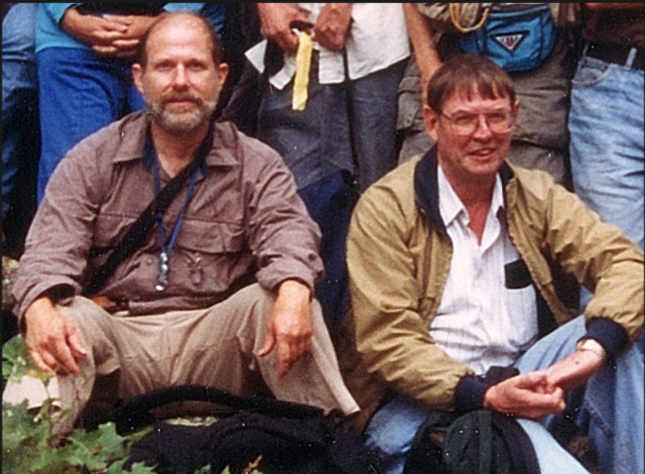Photo: Philip May (left) out exploring for lichen.
Phillip F. May was a teacher, educator and investor while living in Belmont. However, his passion for more than a quarter century revolved around exploring the world for that strange composite organism in which fungi live in a symbiotic relationship with algae.
May was that very rare breed: he hunted lichen; on walls, trees, rocks, forest and dales around the globe.
While May, who died last year at 68 after living in Santa Fe, New Mexico for many years, is best remembered among his fellow lichenists, he will soon have a place in the hearts of the patrons of the Belmont Public Library. In his will, May set aside $212,500 to the Belmont Public Library, the second largest gift in the library’s long history. Only an endowment created by Jane Gray Dustan for educational and enrichment children programming is more significant.
“We are very grateful to Mr. May and his family,” said Belmont Library Director Peter Struzziero, who plans to reach out to the family and “give them a proper thanks.”
“There are some restrictions on how the money can be used that’s in the letter from the attorney settling the estate,” said Gail Mann of the Board of Library Trustees, who will determine how the funds will be allocated.
The amount May provided to the library was approximately five percent of his estate, one of many charitable institutions he provided for which totaled nearly his entire estate.
The gift was a complete surprise as no one in town government or library officials ever met or had contact with May or his wife, Anne. According to town records, May lived on Chester Road for nearly 20 years before moving to Stults Road in the late 1990s. His final address in Belmont was on S. Cottage Road. May is a bit of a mystery as information about this life outside of being a prominent lichenologist is sketchy; there are no life details online nor is there an obituary locally or from New Mexico.
But May’s legacy is secured by the scholarly work as one of the few lichenologists in the world. According to a remembrance written last year in the Friends of the Farlow newsletter (he was the group’s long-time treasurer), he became enthralled with the field of fungi after taking a course at the Harvard Extension School, before focusing on collecting and publishing extensively on the subject.
Long associated with Harvard’s Farlow Reference Library and Herbarium of Cryptogamic Botany, May built a reputation as a keen observer and active explorer – you can read his witty account of lichen hunting in French Guiana. He also sought to assist those newly interested in the field as co-author to a general reference guide entitled “Identifying North American Lichens: A Guide to the Literature.” When he could no longer head out into the field, he generously gave his extensive collection of specimens, research equipment and materials to the Farlow to be handed down to the next generation of explorers.
Late in his career, May was honored by having a species named after him, Parmelia mayi, which can be found in the northern Appalachian mountains.
“If others are interested in town leaving money in their will or making the town a beneficiary … as it’s a great way to give back to the town,” said Adam Dash, Selectmen chair.
“Particularly if it’s to the library,” said Struzziero.









As past Membership chair of the Friends of the Belmont Public library, I can attest that Phil was a generous donor for years to The Friends. His wife Anne, was an active member of the Belmont Garden Club while they lived here. When the Garden Club and The Friends co-sponsored “Books in Bloom,” Anne created a beautiful floral interpretation. Phil proudly attended the first gala at the Library.
I had looked at the May’s lovely former home on Stults Rd. when it was for sale some years ago. The realtor told me the story of the unusual “moss specialist” who had lived there.
What a wonderful story about a unique man who left this special gift to the town of Belmont and its library.
Phil was my neighbor on Stults Road for a number of years. He was an explorer, naturalist, and was often off on adventures–whether by kayak, foot or air. He developed non-shaking Parkinson’s some years back, but didn’t let it slow him down much. He married Anne on his 60th birthday–and, if I have my dates correct, died 11 years later–also on his birthday. Phil and Anne traveled all over the world, even as the Parkinson’s progressed. They renovated their home on Stults Road with a beautiful attic room for Phil’s lichen work. As he became more ill, the steps proved too difficult, and they moved in to the S. Cottage Road condo, where an elevator was installed. Having summered in Santa Fe (they loved the opera) for a number of years, Phil and Anne moved there when it seemed better for his health. After that, we looked forward to our annual holiday letter penned by Phil about their world-wide adventures and their incorrigible dachshunds. I never will forget the day that one of the old maple trees on Stults Road blew over in a storm. Everyone else worried about the damage the tree had done, and how it was blocking the road, but Phil was like a little kid in a candy store–able to glimpse lichen on parts of a tree he normally couldn’t reach.
Thank you so much for adding to this story of a remarkable man who left a true legacy to a pair of communities; his scientific and his residential.